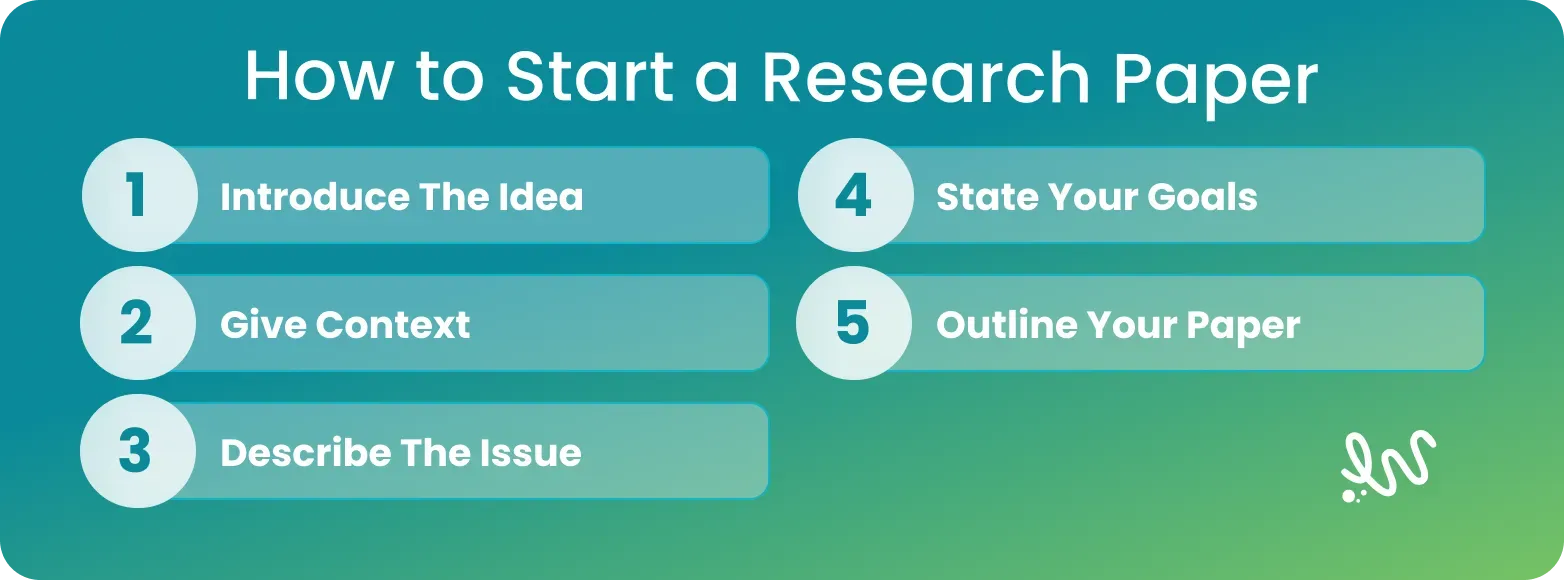The first few lines of a research paper determine everything that's coming. The introductory paragraph influences the reader's expectations and hints at your study. But the benefits go beyond the reader's interest. Remember, a strong research paper intro makes the entire writing process a lot easier. Here are five simple steps you can follow to create a solid opening:
- Introduce the idea
- Give context
- Describe the issue
- State your goals
- Outline your paper
Many students freeze up at this point simply because they're unsure what to say first. That's what this article is here for: to teach you smart ways to kick off a research paper introduction.
If you are still stuck after reading our blog, WriteMyEssay will be there to help. Our professional writers will give you the academic support that takes the stress out of starting.
Short On Time?
Allow a professional writer to step in and take over your tasks so you don't have to stress so much.
Ask For Help
How to Start a Research Paper Intro?
The introduction paragraph is something like an invitation. You're pulling the reader in so they can walk through your thought process with you. When writing an introduction for a research paper, you need to keep it clear and focused, so it feels like the beginning of an interesting conversation.

Introduce the Idea
Your research paper topic should be short and clear right from the beginning. Start with a direct statement informing the reader what your research is about. Then, introduce the topic with a short line explaining why it should be researched.
Example: "This study examines how increasing sea levels have transformed daily life in Southeast Asia's coastal towns over the past twenty years."
Give Context
After naming your topic, paint a quick picture of the bigger context. Share a few of the most important facts that others have already discovered about this particular issue. The background information section should give the reader enough context in just a few words.
Example: "Earlier studies have discussed coastal flooding's risks to structures and local economies, but not many have looked into how they affect migration streams within the most exposed communities."
Describe the Issue
Now it's time to show the gap your paper addresses. Your research paper exists because you found a problem you thought was worth discussing. Describe it so the reader also sees why it needs an answer.
Example: "Climate-related migration has been widely studied, but data on how internal displacement influences long-term community development remains scarce."
State Your Goal
Every paper needs clear objectives. One of the most important parts of the introduction is the description of your goals. Be direct when talking about what you plan to achieve with your research. Let the reader see the questions driving your work.
Example: "This paper aims to analyze internal migration patterns caused by rising sea levels and to assess their social and economic effects on coastal populations."
Outline the Paper
Hint at the paper's structure so the reader knows how it's organized by the end of the intro. They should know what you're going to discuss, so they know what's coming next. At this stage, you should also proofread your paper so all grammatical structures and punctuation marks are in the right places.
Example: "The first section reviews existing studies on climate-driven migration. The next section examines field data collected from three coastal regions. The final section discusses the findings and their implications for future policies."
Why Do You Need a Research Paper Intro?
The opening section of a research paper is the foundation of your entire work. It introduces the idea and prepares the reader for everything that follows. Here's its purpose:
- Presenting the topic and inviting the reader in.
- Providing enough background so the context is clear.
- Pointing out the problem your study is addressing.
- State the goal of your research.
- Outline the paper's structure so readers know what to expect.
Research Paper Introduction Examples
Looking at real examples of an introduction for a research paper can make the process much easier to understand. These samples show how different topics can be introduced clearly while keeping the reader engaged.
Example 1:
"Urban heat islands are a growing problem in developing cities. In this study, green roof installations are examined in terms of how they reduce surface temperatures and improve air quality within densely urbanized cities. Among five major metropolitan cities, the study identifies real-world solutions to reduce the effects of urban heat."
Example 2:
"Antibiotic resistance is one of the greatest threats to global health today. While many studies of resistant bacteria have been conducted, the agricultural use of antibiotics and their role in the crisis have been widely overlooked. This essay explores the connection between agriculture and the resistance trend, casting light on policies that can stem the rise of resistant strains."
Example 3:
"Social media changed how youth interact with one another, but whether and how it influences mental health remains a query. The present study examines the influence of excessive social media usage on anxiety and self-esteem in teenagers. The findings of this study have implications for informing healthier internet usage during adolescence."
Pulling It All Together
A research paper becomes a lot less intimidating once you know what to say first. When the introduction is strong, the whole project falls into place naturally. And as long as you can describe your topic and share enough background, you can count on your introduction paragraph to be solid.
If you ever catch yourself thinking, ‘I need someone to write my research paper for me,’ WriteMyEssay is always just a few clicks away. Connect with one of our professional writers and delegate your tasks to them so you can focus on resting for a while.
FAQ
How Long Should an Introduction Be for a Research Paper?
The length depends on the size of the paper. Shorter projects need just a few paragraphs, while longer works, like these, will need detailed openings.
How to Start Writing a Research Paper?
Start by getting clear on your topic and gathering sources to fully understand the subject. Before you write anything, create a simple outline. Focus first on why what you want to explore matters. Once you have this clarity, drafting everything else becomes easier.
How to Write an Intro for a Research Paper?
You should open with a clear statement of your topic. A bit of background information is also needed so the reader isn't dropped straight into action. Then, you can address the specific problem your study will address. Don't forget to briefly describe how the paper is organized.
Sources
- Kallestinova, E. D. (2011). How to Write Your First Research Paper. The Yale Journal of Biology and Medicine, 84(3), 181. https://pmc.ncbi.nlm.nih.gov/articles/PMC3178846/
- Dange, R. (n.d.). Mastering the Art of Research Paper Writing: A Comprehensive Guide. Cambridge Centre for International Research (CCIR) | Knowledge Network. https://cambridge-research.org/blogs/how-to-write-a-research-paper/



